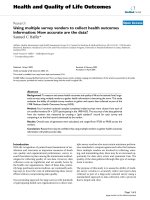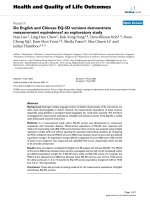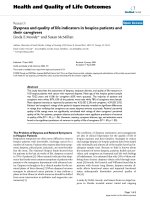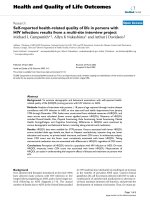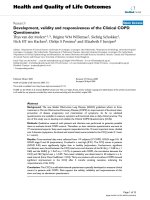Health and Quality of Life Outcomes BioMed Central Research Open Access Using multiple survey docx
Bạn đang xem bản rút gọn của tài liệu. Xem và tải ngay bản đầy đủ của tài liệu tại đây (213.11 KB, 6 trang )
BioMed Central
Page 1 of 6
(page number not for citation purposes)
Health and Quality of Life Outcomes
Open Access
Research
Using multiple survey vendors to collect health outcomes
information: How accurate are the data?
Samuel C Haffer*
Address: Quality Measurement and Health Assessment Group, U.S. Centers for Medicare & Medicaid Services, MS: S3-02-01, 7500 Security
Boulevard, Baltimore, Maryland 21244, USA and Policy Sciences Graduate Program, University of Maryland Baltimore County, Baltimore,
Maryland USA
Email: Samuel C Haffer* -
* Corresponding author
Abstract
Background: To measure and assess health outcomes and quality of life at the national level, large-
scale surveys using multiple vendors to gather health information is becoming the norm. This study
evaluates the ability of multiple survey vendors to gather and report data collected as part of the
1998 Medicare Health Outcomes Survey (HOS).
Method: Four hundred randomly sampled completed mailed surveys were chosen from each of
six certified vendors (N = 2397) participating in the 1998 HOS. The accuracy of the data gathered
from the vendors was measured by creating a "gold standard" record for each survey and
comparing it to the final record submitted by the vendor.
Results: Overall rates of agreement were calculated, and ranged from 97.0% to 99.8% across the
vendors.
Conclusion: Researchers may be confident that using multiple vendors to gather health outcomes
information will yield accurate data.
Introduction
With the recognition of patient-based assessments of sat-
isfaction and outcomes as important measures of heath
care quality and organizational performance, survey re-
search has taken its place among the mainstream method-
ologies for collecting quality of care data. However, data
collection costs are significant and are usually borne by
the health care organizations. Users of these data, prima-
rily large purchasers and accreditors, are continually seek-
ing ways to lower the costs of administering these survey
efforts without compromising data quality.
One promising approach for large surveys with hundreds
of participating health care organizations is to allow mul-
tiple survey vendors who meet certain minimum perform-
ance standards to compete against each other for business.
Since multiple vendors are involved in collecting, enter-
ing, and transmitting data, there may be an increased op-
portunity for data entry errors and systematic bias. The
quality of the data gathered through this type of arrange-
ment is unclear.
The purpose of this study is to assess the ability of multi-
ple survey vendors to accurately collect and report data
collected as part of a large-scale national survey using a
standardized approach to data collection with a protocol
that is simple and clear.
Published: 16 April 2003
Health and Quality of Life Outcomes 2003, 1:6
Received: 5 February 2003
Accepted: 16 April 2003
This article is available from: />© 2003 Haffer; licensee BioMed Central Ltd. This is an Open Access article: verbatim copying and redistribution of this article are permitted in all media
for any purpose, provided this notice is preserved along with the article's original URL.
Health and Quality of Life Outcomes 2003, 1 />Page 2 of 6
(page number not for citation purposes)
Background
In response to demands by stakeholders and the evolving
field of quality measurement, the Centers for Medicare &
Medicaid Services Care (CMS) forged a public-private
partnership with the National Committee for Quality As-
surance (NCQA), a not-for-profit managed care accredita-
tion organization best known for its work in producing
the annual Health Plan Employer Data and Information
Set (HEDIS
®
). The goal of this initiative was to develop
and implement the first outcome measure which would
assess the health status of Medicare beneficiaries in man-
aged care plans. In 1997 NCQA's HEDIS oversight body,
the Committee on Performance Measurement, adopted
and endorsed the Medicare Health Outcomes Survey
(HOS) [formerly the Health of Seniors survey] as a HEDIS
3.0 measure for Medicare plans, in effect mandating its
use />. The design of the in-
strument, survey methodology, and implementation of
the HOS in 1998 have been well documented [1,2].
To summarize, the survey instrument consists of the Short
Form-36 (SF-36) health status questionnaire as its core
supplemented with demographic, clinical variables as
well as questions which assess Activities of Daily Living
(ADLs). The instrument was administered to a random
sample of 1000 Medicare beneficiaries continuously en-
rolled for six months in each managed care plan market
area with a Medicare contract in place on or before Janu-
ary 1, 1997. In plans with 1000 or fewer Medicare enroll-
ees, all eligible members were surveyed. The sampling
frame included the aged and the disabled, but excluded
those eligible for Medicare because of End-Stage Renal
Disease. The survey was administered to the cohort at
baseline and will be administered again to the same group
in two years. A new cohort will be selected each year for
baseline measurement.
Wave one data collection began in May 1998. Surveys
were mailed to 279,135 beneficiaries in 287 managed care
plan market areas. Completed surveys were received from
167,096 for an overall response rate of 60%. 145,203 of
the completed surveys were returned by mail (87%). The
remainder was completed using Computer Assisted Tele-
phone Interviewing (CATI) techniques.
To ensure the validity and reliability of the data, managed
care plans were instructed to contract with one of six
NCQA-certified vendors for administration of the survey.
To achieve NCQA certification, a survey vendor must
demonstrate prior experience in administering health sta-
tus surveys with particular expertise in administering ei-
ther the SF-36 or SF-12, undergo intense scrutiny of their
internal operations, complete an intensive two day train-
ing program, and submit a comprehensive quality assur-
ance plan against which their performance was judged [1].
As part of the data entry protocol, CMS and NCQA al-
lowed vendors to use either optical character recognition
(scanning) technology or manual data entry. If manually
entering the data, CMS and NCQA required vendors to
perform 100% double data entry.
During the computer assisted telephone interviewing
(CATI) component of the survey, NCQA-certified vendors
were required to demonstrate and document an inter-
viewer monitoring rate of 10%. This measure was imple-
mented to verify survey responses. A minimum of 5% of
all survey monitoring was to be "silent" with survey super-
visors listening to interviewers as they completed the HOS
over the telephone with respondents. A minimum 2% call
back rate was established for respondents who had com-
pleted surveys to verify survey completion and to ascertain
the quality and professionalism of the interviewer. The re-
maining 3% were distributed between either of the two
categories at the vendor's discretion.
Using multiple vendors to gather health care data is be-
coming quite commonplace. Multiple vendors are used in
gathering health outcomes information as well as patient
satisfaction data. A potential source of bias exists however
when considering the possibility of data entry errors
across all vendors. This increased chance of error may re-
sult from vendor differences in interpretation of data spec-
ifications, variations in staff training, and inconsistent
implementation of the survey protocol.
To assure the integrity of the data collection process for
the Health Outcomes Survey, CMS designed a data con-
sistency validation project utilizing independent data col-
lection experts, the Clinical Data Abstraction Centers
(CDACs). CDACs have been used extensively in the col-
lection and validation of clinical data for quality improve-
ment projects [3,4].
Methods
Four hundred randomly sampled hard copy surveys were
selected by CMS staff from all mailed surveys coded as be-
ing completed surveys. By definition a completed survey
was one on which 3 critical items were answered as well as
80% of the remaining survey items excluding a 5 question
battery on smoking behavior [1].
A request for photocopies of the each of the surveys select-
ed for the reliability study was forwarded by CMS through
NCQA to the six vendors. Vendors then mailed photocop-
ies of the instruments directly to the CDACs (Figure 1).
CMS contracting requirements require that CDAC work-
load be distributed equally between CDACs depending
on the geographic location of the vendor. Therefore, cases
from vendors on the Atlantic or Pacific Coasts of the U.S.
were assigned to one CDAC (N = 1197) and cases from
Health and Quality of Life Outcomes 2003, 1 />Page 3 of 6
(page number not for citation purposes)
vendors in the central U.S. were assigned to the other (N
= 1200). Simultaneously, vendor electronic data files,
containing the final data records submitted by the vendor
to NCQA for each of the sampled cases, were provided by
CMS to the CDAC and loaded into the MedQuest http://
cms.hhs.gov/medquest/ internal quality control database
module.
Using the MedQuest data entry and management tool,
CDAC staff designed a data entry module mirroring the
hard copy HOS instrument. CDAC data entry staff were
trained in the use of the data entry tool and in the decision
rules created by CMS and NCQA and used by the vendors
to address data entry anomalies (see Appendix A). Data
entry personnel were instructed to:
1. Enter exactly what was documented on the form;
2. Enter an "X" for any question where the survey respond-
ent either,
a. Left the question blank,
b. Made a complete mark for more than one answer,
c. Marked between 2 answers, or
d. Recorded an illegible birth year or name;
3. Enter the answer corresponding to a complete mark, if
the survey respondent made both a partial and complete
mark for two different answers to a question; and,
4. If two or more answers were marked for "Highest level
of education", select the highest level of education
marked.
Data from each survey was entered by two different CDAC
data entry staff. Mismatches between data entry staff were
adjudicated by a third party data entry supervisor. The
Figure 1
Data Entry Validation Process
Electronic Data Files Sent to CDAC
CMS
Selects
Sample
Comparison
of Vendor
Electronic
Files and
Gold
Standard
Statistics
Calculated
Vendors
Submit
Hard
Copies
Data
entered by
two
separate
CDAC
Staff
First
Adjudication
Comparison
of Vendor
Electronic
Files and
CDAC
Standard
Gold
Standard
Created
Second
Adjudication
CDAC
Standard
Created
Health and Quality of Life Outcomes 2003, 1 />Page 4 of 6
(page number not for citation purposes)
result of this process produced a CDAC data entry stand-
ard for each survey.
The CDAC data entry standard was compared with the
vendor electronic data record using the MedQuest IQC
application. To minimize potential data entry errors by
the two CDAC data entry staff, mismatches between the
CDAC standard and the vendor standard were compared
to the original hard copy surveys and adjudicated by a
data quality control supervisor. A final "gold standard" for
each survey was created.
Vendor data submitted for each questionnaire were com-
pared to the final "gold standard" developed for each sur-
vey by the CDAC. Reliability statistics were calculated for
each vendor.
Results
Table one presents the results of the data entry reliability
study for the six vendors participating in the 1998 Medi-
care Health Outcomes Survey.
Mean Agreement Rate is the unadjusted overall agreement
rate between each variable in each "gold standard" with
each variable in each of the vendor data records for every
survey sampled (N [variables per vendor] = 40,000).
Mean Agreement Rate varied across vendors from 97.0%
to 99.8%.
A more detailed review of the mismatches by CDAC staff
revealed that, across vendors, questions involving the two
skip patterns were contributing disproportionately to the
overall number of mismatches. A look back at the hard
copy instruments indicated that vendors did not consist-
ently follow the pre-defined data entry rule number 5 that
states that, "if a question was supposed to have been skipped
but was not, the data entry person was to key in the answers ex-
actly as they were written". In many instances data entry
staff chose the answer that was most logical or consistent
with the responses preceding the skip pattern. Our desire
is to have the data set reflect exactly what the respondent
entered. The following example serves to illustrate the
problem inherent in allowing data entry staff to attempt
to rectify data inconsistencies related to skip patterns. A re-
spondent who answers negatively to the smoking screen-
ing question, but completes the remaining battery of
smoking questions, may be considered a smoker, with the
remaining smoking questions considered valid. Alterna-
tively, the respondent may be considered a non-smoker
and answers to the remaining questions would be ig-
nored. We believe that deciding which of these alterna-
tives is correct or to exclude this case from analysis
altogether should be left to the research team.
An adjusted mean agreement rate was computed which
did not penalize the vendors for data entry problems as-
sociated with the skip patterns. These adjusted agreement
rates ranged from 97.9% to 99.9%. The mean adjusted
agreement rate for all vendors was 99.2%.
Another finding worthy to note is that the vendor with the
lowest adjusted agreement score, Vendor C, was found to
have only a 2% agreement on one particular question
where the other vendors achieved an average agreement
rate of 99.5% on the same question. While automated
data entry edits would have detected an out-of-range val-
ue, this problem was traced to a data coding error which
consisted of a misassignment by the vendor of the valid
response values for the question. When corrected, the
overall average adjusted agreement rate for Vendor C in-
creased by one percentage point to 98.9%.
Discussion
Evidence presented here indicates that the use of multiple
vendors to collect health outcomes information need not
compromise the quality of the data collected across
vendor sites. As the results of this study seem to suggest,
researchers may utilize multiple vendors for data collec-
tion using mailed surveys without fear of data quality
problems.
Table 1: Data Entry Reliability Study Results 1998 Medicare Health Outcomes Survey
Vendor (Overall Response Rate) Number of Cases Mean Agreement Rate Mean Agreement Rate Adjusted for
Skip Pattern Problems
A (62%) 400 99.4% 99.4%
B (59%) 397 97.1% 98.6%
C (66%) 400 97.7% 97.9%
D (58%) 400 97.0% 99.9%
E (62%) 400 97.1% 99.7%
F (58%) 400 99.8% 99.8%
All Vendors (60%) 2397 98.0% 99.2%
Health and Quality of Life Outcomes 2003, 1 />Page 5 of 6
(page number not for citation purposes)
This does not mean, however, that health services re-
searchers should not concern themselves with data quality
when using multiple vendors. Conversely, they must es-
tablish the parameters (operating guidelines and proce-
dures) within which the vendors will operate during the
survey implementation, data collection, and data entry
phases of a study. The two guiding principles for ensuring
data quality that were vigorously adhered to during the in-
augural fielding of the Medicare Health Outcomes Survey
were standardization and simplicity.
Standardization
In addition to using a standardized survey administration
protocol and instrument to minimize the potential for
systematic inter-vendor bias, CMS and NCQA developed
data entry rules [Appendix A] and a quality assurance
plan. The quality assurance plan focuses attention on
standardizing five key areas of vendor performance:
1. systems and processes – establishes minimum system
requirements for vendors survey management systems,
CATI systems, and the printing and mailing of survey in-
struments and related materials;
2. maximizing response rates – sets minimum expecta-
tions on the number and type of resources to be utilized
by the vendors to obtain information that provides valid
respondent addresses and telephone numbers;
3. data integrity – institutes minimum standards for qual-
ity of the data including staff training, receipt of the data
by vendor staff, data entry, decision rules, quality moni-
toring of data entry by vendor staff, and preparation and
submission of data files;
4. beneficiary confidentiality – mandates specific require-
ments for confidentiality of person-level data; and,
5. project reporting – establishes uniform reporting and
definitions that allow rapid and accurate vendor-to-ven-
dor progress comparisons throughout the survey
administration.
The most recent HOS Quality Assurance Plan entitled NC-
QA's 2002 Quality Assurance Plan is available for down-
load from the NCQA website at />programs/hedis/hos/2002hosqap.doc.
Simplicity
There is a trade-off between standardization, which re-
quires complex definitions to cover multiple possible re-
sponses, and simplicity, which requires brief, easy to
understand instructions. In implementing the Medicare
Health Outcomes Survey with the largest sample of Medi-
care beneficiaries ever surveyed, CMS and NCQA realized
that technical complexity increases the likelihood for sys-
tematic error especially while ensuring standardization
across multiple vendors.
To realize the goal of simplicity in instrument design, the
survey was limited in scope to only those items necessary
to validly and reliably measure health status over time,
casemix adjust the results, and provide actionable infor-
mation for clinicians and plans to use in improving the
quality of care provided to patients. In addition questions
requiring skip patterns were minimized as they tend to
confuse respondents (and data entry staff as the above re-
sults demonstrate).
An obvious source of potential error was the data file cre-
ation and data transfer processes. To reduce the risk of cor-
rupt files populated with poor quality data, CMS and
NCQA required vendors to output data into an ASCII
fixed-width text file and transmit each plan's data on a
separate 3.5 inch diskette. This file type was one with
which all vendors were familiar, had a great deal of expe-
rience in producing, and required no exceptional techno-
logical sophistication or explanation.
The nationwide implementation of the Medicare Health
Outcomes Survey in managed care has demonstrated the
feasibility of gathering high quality, clinically useful infor-
mation at low cost (approximately US$25 per completed
survey). This was achieved using multiple third party sur-
vey vendors to implement the survey administration pro-
tocol. We believe the analyses presented here indicate that
by employing the principles of standardization and sim-
plicity researchers and project managers can maximize the
probability of collecting high quality data when utilizing
multiple survey vendors in obtaining health outcomes
information.
Appendix A
Data Entry Rules for Cohort One Medicare Health Out-
comes Survey
1. If a respondent marks between two choices and it is ob-
viously closer to one choice than another, select the an-
swer choice that the mark is closest to and the data entry
person should initial the edit.
2. If a respondent's mark falls equidistant between two ad-
jacent choices on a five point scale, flip a coin if the mark
is between 1 and 2, choose 3 if the mark is between 2 and
3, choose 3 if the mark is between 3 and 4, and flip a coin
if the choice is between 4 and 5. If a coin is flipped, heads
equals the value to the right and tails equals the value to
the left. Each time a determination is made the data entry
person should mark the corrected box on the paper copy,
Publish with BioMed Central and every
scientist can read your work free of charge
"BioMed Central will be the most significant development for
disseminating the results of biomedical research in our lifetime."
Sir Paul Nurse, Cancer Research UK
Your research papers will be:
available free of charge to the entire biomedical community
peer reviewed and published immediately upon acceptance
cited in PubMed and archived on PubMed Central
yours — you keep the copyright
Submit your manuscript here:
/>BioMedcentral
Health and Quality of Life Outcomes 2003, 1 />Page 6 of 6
(page number not for citation purposes)
initial the entry and indicate "H" if heads occurred or "T"
if tails occurred.
3. If a value is missing, leave the value blank unless the re-
spondent is called back to ascertain the response.
4. When multiple values are checked inappropriately for a
response category,
– if it is a critical item, call the respondent to obtain a valid
response,
– for all other questions, if the marks are NOT adjacent,
flip a coin. If the marks are adjacent where 1 and 2 are
marked, flip a coin. If 2 and 3 are marked choose 3. If 3
and 4 are marked choose 4. If 4 and 5 are marked, flip a
coin. If a coin is flipped, heads equals the value to the
right and tails equals the value to the left. Each time a de-
termination is made the data entry person should mark
the corrected box on the paper copy, initial the entry and
indicate "H" if heads occurred or "T" if tails occurred.
5. If a question was supposed to have been skipped but
was not, the data entry person was to key in the answers
exactly as they were written.
Acknowledgments
The views expressed here are those of the author and do not necessarily
represent the position of the Centers for Medicare and Medical Services,
or the U.S Department of Health and Human Services.
Sonya Bowen, CMS; James McCarthy, Oanh Vuong, Kristin Spector, and
Lori Andersen, National Committee for Quality Assurance; Maria Caschet-
ta, FMAS Corporation; Susan Guiswite, and Sean Warner, DynKePRO con-
tributed to this effort.
References
1. National Committee for Quality Assurance Health of Seniors
Manual.: HEDIS 3.0/1998 Volume 6 Washington, DC 1998,
2. Bierman AS, Lawrence WF, Haffer SC and Clancy CM Functional
Health Outcomes as a Measure of Health Care Quality for
Medicare Beneficiaries Health Services Research 2001, 35(6 Part
II):90-108
3. Marciniak TA, Ellerbeck EF, Radford MJ, Kresowik TF, Gold JA, Krum-
holz HM, Kiefe CI, Allman RM, Vogel RA and Jencks SF Improving
the quality of care for Medicare patients with acute myocar-
dial infarction: Results from the Cooperative Cardiovascular
Project pilot Journal of the American Medical Association 1998,
279:1351-1357
4. Marciniak TA, Mosedale L and Ellerbeck EF Quality Improvement
at the National Level: Lessons from the Cooperative Cardi-
ovascular Project Evaluation & The Health Professions 1998,
21(4):525-536


